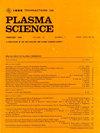金属化层与金属化膜自愈形态的结构-功能关系研究
IF 1.3
4区 物理与天体物理
Q3 PHYSICS, FLUIDS & PLASMAS
引用次数: 0
摘要
金属化聚丙烯薄膜电容器(mppfc)以其独特的自愈性能在电子器件中得到了广泛的应用。本工作旨在探讨金属化聚丙烯膜(MPPF)中金属化层结构参数与自愈性能之间的相关机制。与较薄的电极层相比,较厚的电极层具有更不规则的自愈形态,并且在相同的自愈区域恢复绝缘需要更多的能量,较厚的电极层具有更大的附着力,并且在$5~\Omega / \square$厚度下的均方根(rms)是50- $\Omega / \square$电极层厚度下的2.67倍。不同表面形貌和电位差是导致MPPF自愈形态不同的原因,这对自愈性能起着重要作用,5- $\Omega / \square$电极厚度下的电位差为149.2 mV,是50- $\Omega / \square$电极厚度下的1.92倍。仿真模型显示了等离子体在自愈过程中发展的不同阶段,等离子体在自愈的最后阶段发展迅速,然后减慢。自愈等离子体的最高电子温度可达4000 K以上。该模型还解释了黏附力对自愈等离子体的影响机理以及等离子体过程中介电层结构的变化,在500 W/m2时,热通量为$0.19~\mu $ m,而在1 W/m2时,碳化深度为$0.65~\mu $ m,增加了三倍。本文章由计算机程序翻译,如有差异,请以英文原文为准。
Study on the Structure–Function Relationship Between Metallized Layer and Self-Healing Morphology in Metallized Film
Metallized polypropylene film capacitors (MPPFCs) are widely used in electronic devices for their unique merits: self-healing. This work aims to explore the correlation mechanism between metallized layer structural parameters and self-healing properties in metallized polypropylene film (MPPF). The thicker electrode layer has a more irregular self-healing morphology and needs more energy to restore insulation at the same self-healing area compared to the thinner electrode layer, and the thicker electrode layer has a greater adhesive force, and the root mean square (rms) at $5~\Omega / \square$ thickness is 2.67 times larger than that at 50- $\Omega / \square$ electrode layer thickness. Different surface morphologies of MPPF and different potential differences are the reasons for different self-healing morphologies, which play an important role in self-healing properties, the potential difference at 5- $\Omega / \square$ electrode thickness is 149.2 mV, 1.92 times larger than that at 50- $\Omega / \square$ electrode thickness. The simulation model shows the different stages of plasma development in self-healing, and the plasma develops fast and then slows down in the final stage. The maximum electron temperature in self-healing plasma can reach over 4000 K. The model also explains the influence mechanism of adhesion force on the self-healing plasma and the structure change of the dielectric layer during the plasma process, the carbonized depth in 500 W/m2, thermal flux is $0.19~\mu $ m, but in 1 W/m2, and the carbonized depth is $0.65~\mu $ m, which is a threefold increase.
求助全文
通过发布文献求助,成功后即可免费获取论文全文。
去求助
来源期刊

IEEE Transactions on Plasma Science
物理-物理:流体与等离子体
CiteScore
3.00
自引率
20.00%
发文量
538
审稿时长
3.8 months
期刊介绍:
The scope covers all aspects of the theory and application of plasma science. It includes the following areas: magnetohydrodynamics; thermionics and plasma diodes; basic plasma phenomena; gaseous electronics; microwave/plasma interaction; electron, ion, and plasma sources; space plasmas; intense electron and ion beams; laser-plasma interactions; plasma diagnostics; plasma chemistry and processing; solid-state plasmas; plasma heating; plasma for controlled fusion research; high energy density plasmas; industrial/commercial applications of plasma physics; plasma waves and instabilities; and high power microwave and submillimeter wave generation.
 求助内容:
求助内容: 应助结果提醒方式:
应助结果提醒方式:


